I carried out a study of the use of rakes for excavating mines as part of the GICHD Manual Demining Study. I also worked with the REDS system in Sri Lanka and later in Jordan (where metal-detector signals were routinely excavated using the same rakes with great success). For a study about the safety of excavation using rakes, see this Powerpoint presentation Click here.
There are as many kinds of rake as there are types of hammer, and rather more ways of using them than there are ways of using a hammer. A rake can be designed so that it detonates pressure-mines, or so that it lifts them. It can be designed to be banged into the ground, or designed to dig itself in as it is drawn forward. During the GICHD study, I found examples of all kinds - but was really impressed by one combination rake-drill called the Rake Excavation and Detection System (REDS) developed by Luke Atkinson.

What follows is a detailed summary of the REDS.
RAKE EXCAVATION AND DETECTION SYSTEM - REDS
The REDS has been developed by NPA Sri Lanka under Luke Atkinson's leadership since 2002. It is surprising how many others were keen to claim it after it had attracted positive attention, but the only demining groups using REDS today are those under the direct influence of NPA in Sri Lanka and Jordan. Other groups have copied (literally) NPA's SOPs, but not understood the principles behind REDS and so have made changes to the tools and the procedures that reduce safety for the deminer and the end-user of the land. Some of those nominally controlling demining in Sri Lanka have also claimed responsibility for REDS - and even claimed that the rakes are their designs. In truth, the design of rake that they refer to is not even featured in the REDS as it is performed today.
Heavy rakes with impacting tines have been used by the armed forces throughout Asia to find landmines for many years. REDS rakes are not like them. REDS relies on the use of a “heavy” and a “light” rake. While the terms “heavy” and “light” describe their weight, they do not describe their function. The heavy rake is used to break up the ground and the light rake is used to move the loosened spoil back as the excavation advances. To reflect the different functions, they are sometimes renamed respectively as Harrow-rakes and Brush-rakes. Both have long handles - between 1.5 and 2 metres long - and have been designed to make detonation of anti-personnel pressure-mines very unlikely. When the soil structure is loose, the Harrow-rake may not be needed but the Brush-rake is always required to move loose soil back from the front of the excavation. It is also used to maintain a channel at the sides of a deminer's clearance lane to facilitate QA depth inspections.
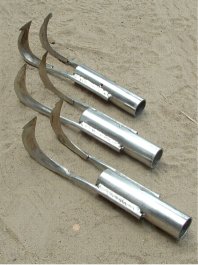
Shown above are the heads of my designs of Harrow-rake. WIth two-tines curved to dig in as the rake is drawn forward, the tool makes deep cuts in the ground surface. The inside of the curve on each tine can be sharpened to cut small roots. The tips of the tines can be shaped to increase the depth to which the tool digs. In soft ground, the tool frequently lifts mines to the surface without applying pressure to the top. In harder ground it prepares the ground for the use of the Brush-rake.
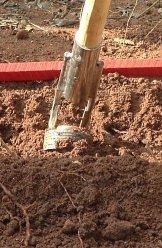
A RANGAN-99 anti-personnel blast mine being lifted to the surface by a Harrow rake.
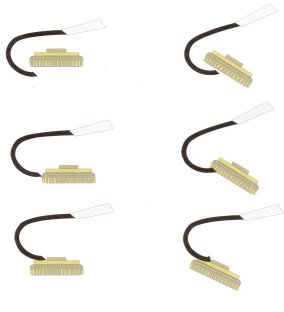
How the Harrow-rake tines lift mines.
The safety and performance relies on the design of the rakes. The long handles have kept deminers a useful distance from accidental initiations, and allowed deminers to work in an upright position. The work is repetitive and requires considerable effort, and the standing position makes this sustainable. The two-tine Harrow-rake performs well at scarifying the ground and raising mines out of loose ground. With many thousands of mines exposed using it, there have been more than thirty recorded accidental initiations and the only serious injury has been to eyes when the deminer's visor or mask was raised.
Critical to understanding how most area-excavation systems work, is the 'Base-trench'. The REDS system starts by using the rakes to create a 'Base-trench' in a safe area before the start of a search lane. The 'Base-trench' is similar to a 'Base-stick' used when using a metal-detector. It is advanced as the excavation progresses, and replaces some of the functions of the Base-stick. It is a trench across the start of the lane that is as deep as the required search depth and extends 20-50cm front to back. It has a vertical face on the unsearched side, and a sloping face on the safe side.
The Brush-rake is used to move soil back in the Base-trench, and so advance the excavation. With tines spread in a fan design, the downward pressure applied by the user is spread over a wide area and the easy flexibility of each tine prevents pressure being concentrated in any one place. A slight downward bend towards the end of each tine helps to collect loose spoil and sweep it back towards the deminer. Only one accidental initiation is recorded as having occurred while using the Brush-rake (no injury), which is believed to be inherently 'safer' than designs which concentrate weight and force in the small area at the point of a few tines.

The above are Brush-rakes - sometimes also known as 'leaf-rakes'. Their first use was in Kosovo to remove leaf litter covering PMA-2 and PMA-3 mines - without incident and at great speed. Different designs may be used, but the principle remains the same. The tool is used like a stiff broom to brush loosened spoil back towards the deminer. When a mine is encountered with the Brush-rake, it is exposed without applying enough pressure to make it function. The flexible rake tines bend out of the way selectively when encountering a hard object and do not transfer the brushing force to the object in the way that might be expected. I carried out a test with a Type-72 AP blast mine, using the Brush-rake to expose it and then trying to use it to detonate the device (main charge removed). I could not make it detonate. Similar 'tests' has been conducted by NPA to demonstrate the inherent safety of the Brush-rake. [ I later tried to initiate a PMN mine without success.]
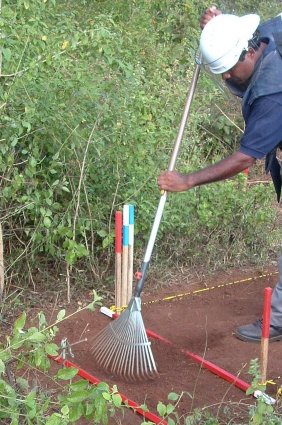
After cutting the undergrowth, the Brush-rake is used to remove any loose vegetation and 'leaf litter' from the area in front of the Base-trench (which may be marked with a base-stick as shown). If the ground is soft enough, the Brush-rake may then be used to brush the soil towards the Base-trench. After the Brush-rake, the Harrow-rake is used in overlapping sweeps leaving furrows across the area being worked – to a distance of about 50cm in front of the base-trench.
The Brush-rake has exposed many thousands of mines safely in Sri Lanka and Jordan. The picture below shows a mine exposed by the Brush-rake. As if often the case, this mine was shallow but REDS can be used to sift the soil to any depth.
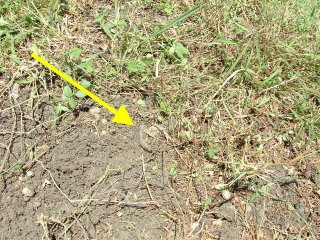
The picture below shows the way that the lanes are marked with side-trenches to allow internal QA of the depth. The Base-trench at the end of the lane advances as the deminer works. After QA, the side trenches can be erased as the searched and cleared area extends.

The REDS method sifts the soils to the required depth and so gives a total confidence that nothing remains concealed within that depth. Small detonators and parts of devices are reliably found. This makes it very attractive when considering the safety of the end-users of the land. A study of the available accident reports implies that it is safer than any other area-excavation methods for the deminer. Other methods usually put the deminers on their knees and close to any initiation, and also require such force that initiations occur with distressing frequency. The long handle of the REDS rakes keeps the deminer's hands and head well away from an initiation, and the rake designs minimise the chance of accidental initiations.
In Sri Lanka, the anti-personnel blast mine-types are limited to VS-50s, Type-72s, P4 Mks 1&2 and the RANGAN-99 (sometimes known as the Jonny-99). 50g TNT and 45g RDX are the largest High Explosive content among them. There is also a battery initiated wooden Jonny-66 with a varied explosive content (PE) that may sometimes exceed 100g, but these are not common, and even less commonly in a functional state because rain short-circuits their electrical initiation system. Mines exposed safely in other countries include the M14, M15, M19, PRB M35 and VS50.The evidence from the few accidents that have occurred with similar rakes implies that as long as a deminer wears effective eye protection, the deminer can expect to escape an initiation without any serious injury. The evidence from all accidents in the Database of Demining Accidents implies that the risk involved in excavating any blast mine with rakes is lower than when excavating with other hand-tools. See the Rake Case Study in Jordan.
The REDS has been successfully used in a range of ground conditions, including dense-vegetation, extensive root systems, hard ground and ground with large rocks. While sometimes slow, the rakes were effective and safe - and any other area excavation method would also have been slow.
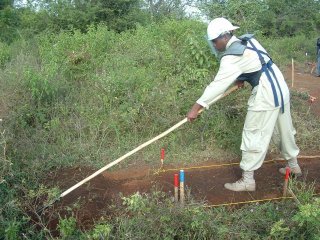
Quality Control and Assurance with the REDS system
As with most area excavation procedures, the spoil excavated is moved back inside the originally suspect area. It may contain high levels of metal contamination or be comprised of soil with a high GRH (electromagnetic signature) so the work cannot be subjected to post-clearance sampling and Quality Control using a metal-detector. Post clearance sampling would require the post-clearance team to also use the REDS system. On land recently raked and so root free, this can be comparatively fast and effortless, so may sometimes be considered appropriate. When ground that had not been raked was reached, this would usually be apparent and so the working depth could be reliably verified with random sampling.
The REDS incorporates a side-of-lane ditch system that allows post and tape marking to remain in place during raking and facilitates internal QA checks that the required excavation depth has been maintained. Side-of lane ditches are only “lost” when cleared areas are raked over after QA. Internal Quality Assurance by the Supervisors checks the depth of the side-of-lane trenches and also checks that the sieved spoil inside the lane is a regular height. Deminers could "cheat" by only raking the side-trench to the right depth, but variations in the height of the spoil created would give them away. The Supervisors check each man's work two or three times during a 30 minute work period, so there is little chance of successfully deceiving them. This is an effective method of allowing QA by Supervisors and provides great confidence that the required clearance depth has been maintained.
You may wonder why a deminer would want to deceive the Supervisor. The answer is that the deminers are frequently obliged to search breaches through areas where they believe there are no mines. When they find mines, they are usually very close to the surface. So a deminer may resent the strict requirement to maintain depth in an area where there is no apparent need.
Confidence in the REDS
When the full REDs is implemented, it is probable that a device the size of a coat-button would have been located. There is a higher chance of locating detonators and broken parts of devices than with any other demining method I have seen. It is not always possible to make that kind of statement of confidence when metal-detectors are used, and is rarely possible when metal-detectors are used to search for minimum-metal mines in difficult soil conditions. This is not always because the metal-detector is incapable of locating the target. It is also because getting optimal performance from a metal-detector is difficult, and common methods of gaining confidence about this are not always reliable.
The REDS system is simple and can be seen to reliably achieve thorough search and clearance to a set depth. The entire system integrates conventional mined-area disciplines regarding area marking, working distances, internal QA, etc., and overcomes all of the problems previously associated with the use of rakes. The system is also very low-cost in terms of equipment needs, and labour intensive. The latter ensures that a human mind and eye is present at all times, and many consider that this is a better guarantee of quality than any other check.
Some accidents during Humanitarian Demining are recorded as 'unavoidable'” in the Database of Demining Accidents. Most of the unavoidable accidents occur while a deminer is investigating a metal-detector signal or excavating the ground for another reason. When these accidents are non-injurious, the demining group’s methods and PPE provision are vindicated. No accidental initiation is a cause for celebration, but non-injurious accidents come close.
Area excavation with mattocks, pick-axes and improvised tooling is widely practiced throughout the HD industry. Accidents with these tools frequently result in severely disabling injury. One reason why this has not occurred with the REDS is undoubtedly the stand-off distance achieved by the long handles used. From the information made available, and from observing the REDS system in use, it is apparent that the system has safety advantages over other methods of excavation. The only reason to append any reservation to that statement is a minor concern about the consistent quality and condition of the rakes that are used. My own designs will not separate in a blast, but some will.
The endorsement of REDS given above does NOT apply when partial copies of the REDS are devised and implemented. Some of those that I have seen use different rake-heads and omit all chance of QA. These are, in my opinion, unacceptably and unnecessarily dangerous.
See also this Rake Case Study and the detailed use of rakes described in Chapter 6 of the Global SOPs.
HOME
|